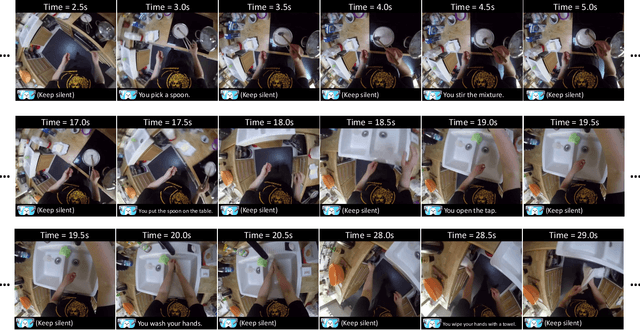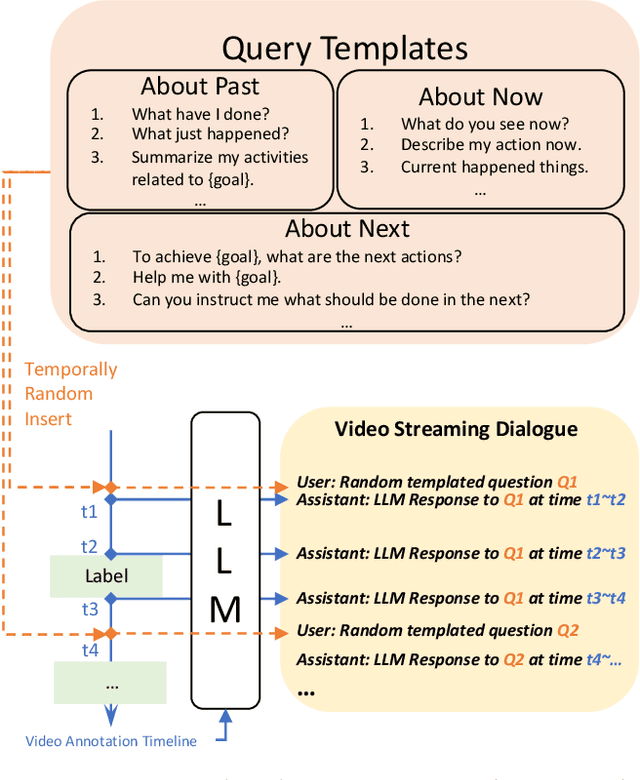Jia-Wei Liu
DD-Ranking: Rethinking the Evaluation of Dataset Distillation
May 19, 2025Abstract:In recent years, dataset distillation has provided a reliable solution for data compression, where models trained on the resulting smaller synthetic datasets achieve performance comparable to those trained on the original datasets. To further improve the performance of synthetic datasets, various training pipelines and optimization objectives have been proposed, greatly advancing the field of dataset distillation. Recent decoupled dataset distillation methods introduce soft labels and stronger data augmentation during the post-evaluation phase and scale dataset distillation up to larger datasets (e.g., ImageNet-1K). However, this raises a question: Is accuracy still a reliable metric to fairly evaluate dataset distillation methods? Our empirical findings suggest that the performance improvements of these methods often stem from additional techniques rather than the inherent quality of the images themselves, with even randomly sampled images achieving superior results. Such misaligned evaluation settings severely hinder the development of DD. Therefore, we propose DD-Ranking, a unified evaluation framework, along with new general evaluation metrics to uncover the true performance improvements achieved by different methods. By refocusing on the actual information enhancement of distilled datasets, DD-Ranking provides a more comprehensive and fair evaluation standard for future research advancements.
Balanced Image Stylization with Style Matching Score
Mar 10, 2025Abstract:We present Style Matching Score (SMS), a novel optimization method for image stylization with diffusion models. Balancing effective style transfer with content preservation is a long-standing challenge. Unlike existing efforts, our method reframes image stylization as a style distribution matching problem. The target style distribution is estimated from off-the-shelf style-dependent LoRAs via carefully designed score functions. To preserve content information adaptively, we propose Progressive Spectrum Regularization, which operates in the frequency domain to guide stylization progressively from low-frequency layouts to high-frequency details. In addition, we devise a Semantic-Aware Gradient Refinement technique that leverages relevance maps derived from diffusion semantic priors to selectively stylize semantically important regions. The proposed optimization formulation extends stylization from pixel space to parameter space, readily applicable to lightweight feedforward generators for efficient one-step stylization. SMS effectively balances style alignment and content preservation, outperforming state-of-the-art approaches, verified by extensive experiments.
Skinned Motion Retargeting with Dense Geometric Interaction Perception
Oct 28, 2024Abstract:Capturing and maintaining geometric interactions among different body parts is crucial for successful motion retargeting in skinned characters. Existing approaches often overlook body geometries or add a geometry correction stage after skeletal motion retargeting. This results in conflicts between skeleton interaction and geometry correction, leading to issues such as jittery, interpenetration, and contact mismatches. To address these challenges, we introduce a new retargeting framework, MeshRet, which directly models the dense geometric interactions in motion retargeting. Initially, we establish dense mesh correspondences between characters using semantically consistent sensors (SCS), effective across diverse mesh topologies. Subsequently, we develop a novel spatio-temporal representation called the dense mesh interaction (DMI) field. This field, a collection of interacting SCS feature vectors, skillfully captures both contact and non-contact interactions between body geometries. By aligning the DMI field during retargeting, MeshRet not only preserves motion semantics but also prevents self-interpenetration and ensures contact preservation. Extensive experiments on the public Mixamo dataset and our newly-collected ScanRet dataset demonstrate that MeshRet achieves state-of-the-art performance. Code available at https://github.com/abcyzj/MeshRet.
VideoLLM-online: Online Video Large Language Model for Streaming Video
Jun 17, 2024



Abstract:Recent Large Language Models have been enhanced with vision capabilities, enabling them to comprehend images, videos, and interleaved vision-language content. However, the learning methods of these large multimodal models typically treat videos as predetermined clips, making them less effective and efficient at handling streaming video inputs. In this paper, we propose a novel Learning-In-Video-Stream (LIVE) framework, which enables temporally aligned, long-context, and real-time conversation within a continuous video stream. Our LIVE framework comprises comprehensive approaches to achieve video streaming dialogue, encompassing: (1) a training objective designed to perform language modeling for continuous streaming inputs, (2) a data generation scheme that converts offline temporal annotations into a streaming dialogue format, and (3) an optimized inference pipeline to speed up the model responses in real-world video streams. With our LIVE framework, we built VideoLLM-online model upon Llama-2/Llama-3 and demonstrate its significant advantages in processing streaming videos. For instance, on average, our model can support streaming dialogue in a 5-minute video clip at over 10 FPS on an A100 GPU. Moreover, it also showcases state-of-the-art performance on public offline video benchmarks, such as recognition, captioning, and forecasting. The code, model, data, and demo have been made available at https://showlab.github.io/videollm-online.
Towards A Better Metric for Text-to-Video Generation
Jan 15, 2024Abstract:Generative models have demonstrated remarkable capability in synthesizing high-quality text, images, and videos. For video generation, contemporary text-to-video models exhibit impressive capabilities, crafting visually stunning videos. Nonetheless, evaluating such videos poses significant challenges. Current research predominantly employs automated metrics such as FVD, IS, and CLIP Score. However, these metrics provide an incomplete analysis, particularly in the temporal assessment of video content, thus rendering them unreliable indicators of true video quality. Furthermore, while user studies have the potential to reflect human perception accurately, they are hampered by their time-intensive and laborious nature, with outcomes that are often tainted by subjective bias. In this paper, we investigate the limitations inherent in existing metrics and introduce a novel evaluation pipeline, the Text-to-Video Score (T2VScore). This metric integrates two pivotal criteria: (1) Text-Video Alignment, which scrutinizes the fidelity of the video in representing the given text description, and (2) Video Quality, which evaluates the video's overall production caliber with a mixture of experts. Moreover, to evaluate the proposed metrics and facilitate future improvements on them, we present the TVGE dataset, collecting human judgements of 2,543 text-to-video generated videos on the two criteria. Experiments on the TVGE dataset demonstrate the superiority of the proposed T2VScore on offering a better metric for text-to-video generation.
ShowRoom3D: Text to High-Quality 3D Room Generation Using 3D Priors
Dec 20, 2023Abstract:We introduce ShowRoom3D, a three-stage approach for generating high-quality 3D room-scale scenes from texts. Previous methods using 2D diffusion priors to optimize neural radiance fields for generating room-scale scenes have shown unsatisfactory quality. This is primarily attributed to the limitations of 2D priors lacking 3D awareness and constraints in the training methodology. In this paper, we utilize a 3D diffusion prior, MVDiffusion, to optimize the 3D room-scale scene. Our contributions are in two aspects. Firstly, we propose a progressive view selection process to optimize NeRF. This involves dividing the training process into three stages, gradually expanding the camera sampling scope. Secondly, we propose the pose transformation method in the second stage. It will ensure MVDiffusion provide the accurate view guidance. As a result, ShowRoom3D enables the generation of rooms with improved structural integrity, enhanced clarity from any view, reduced content repetition, and higher consistency across different perspectives. Extensive experiments demonstrate that our method, significantly outperforms state-of-the-art approaches by a large margin in terms of user study.
X-Adapter: Adding Universal Compatibility of Plugins for Upgraded Diffusion Model
Dec 06, 2023



Abstract:We introduce X-Adapter, a universal upgrader to enable the pretrained plug-and-play modules (e.g., ControlNet, LoRA) to work directly with the upgraded text-to-image diffusion model (e.g., SDXL) without further retraining. We achieve this goal by training an additional network to control the frozen upgraded model with the new text-image data pairs. In detail, X-Adapter keeps a frozen copy of the old model to preserve the connectors of different plugins. Additionally, X-Adapter adds trainable mapping layers that bridge the decoders from models of different versions for feature remapping. The remapped features will be used as guidance for the upgraded model. To enhance the guidance ability of X-Adapter, we employ a null-text training strategy for the upgraded model. After training, we also introduce a two-stage denoising strategy to align the initial latents of X-Adapter and the upgraded model. Thanks to our strategies, X-Adapter demonstrates universal compatibility with various plugins and also enables plugins of different versions to work together, thereby expanding the functionalities of diffusion community. To verify the effectiveness of the proposed method, we conduct extensive experiments and the results show that X-Adapter may facilitate wider application in the upgraded foundational diffusion model.
VideoSwap: Customized Video Subject Swapping with Interactive Semantic Point Correspondence
Dec 05, 2023



Abstract:Current diffusion-based video editing primarily focuses on structure-preserved editing by utilizing various dense correspondences to ensure temporal consistency and motion alignment. However, these approaches are often ineffective when the target edit involves a shape change. To embark on video editing with shape change, we explore customized video subject swapping in this work, where we aim to replace the main subject in a source video with a target subject having a distinct identity and potentially different shape. In contrast to previous methods that rely on dense correspondences, we introduce the VideoSwap framework that exploits semantic point correspondences, inspired by our observation that only a small number of semantic points are necessary to align the subject's motion trajectory and modify its shape. We also introduce various user-point interactions (\eg, removing points and dragging points) to address various semantic point correspondence. Extensive experiments demonstrate state-of-the-art video subject swapping results across a variety of real-world videos.
ColonNeRF: Neural Radiance Fields for High-Fidelity Long-Sequence Colonoscopy Reconstruction
Dec 04, 2023Abstract:Colonoscopy reconstruction is pivotal for diagnosing colorectal cancer. However, accurate long-sequence colonoscopy reconstruction faces three major challenges: (1) dissimilarity among segments of the colon due to its meandering and convoluted shape; (2) co-existence of simple and intricately folded geometry structures; (3) sparse viewpoints due to constrained camera trajectories. To tackle these challenges, we introduce a new reconstruction framework based on neural radiance field (NeRF), named ColonNeRF, which leverages neural rendering for novel view synthesis of long-sequence colonoscopy. Specifically, to reconstruct the entire colon in a piecewise manner, our ColonNeRF introduces a region division and integration module, effectively reducing shape dissimilarity and ensuring geometric consistency in each segment. To learn both the simple and complex geometry in a unified framework, our ColonNeRF incorporates a multi-level fusion module that progressively models the colon regions from easy to hard. Additionally, to overcome the challenges from sparse views, we devise a DensiNet module for densifying camera poses under the guidance of semantic consistency. We conduct extensive experiments on both synthetic and real-world datasets to evaluate our ColonNeRF. Quantitatively, our ColonNeRF outperforms existing methods on two benchmarks over four evaluation metrics. Notably, our LPIPS-ALEX scores exhibit a substantial increase of about 67%-85% on the SimCol-to-3D dataset. Qualitatively, our reconstruction visualizations show much clearer textures and more accurate geometric details. These sufficiently demonstrate our superior performance over the state-of-the-art methods.
MD-Splatting: Learning Metric Deformation from 4D Gaussians in Highly Deformable Scenes
Nov 30, 2023



Abstract:Accurate 3D tracking in highly deformable scenes with occlusions and shadows can facilitate new applications in robotics, augmented reality, and generative AI. However, tracking under these conditions is extremely challenging due to the ambiguity that arises with large deformations, shadows, and occlusions. We introduce MD-Splatting, an approach for simultaneous 3D tracking and novel view synthesis, using video captures of a dynamic scene from various camera poses. MD-Splatting builds on recent advances in Gaussian splatting, a method that learns the properties of a large number of Gaussians for state-of-the-art and fast novel view synthesis. MD-Splatting learns a deformation function to project a set of Gaussians with non-metric, thus canonical, properties into metric space. The deformation function uses a neural-voxel encoding and a multilayer perceptron (MLP) to infer Gaussian position, rotation, and a shadow scalar. We enforce physics-inspired regularization terms based on local rigidity, conservation of momentum, and isometry, which leads to trajectories with smaller trajectory errors. MD-Splatting achieves high-quality 3D tracking on highly deformable scenes with shadows and occlusions. Compared to state-of-the-art, we improve 3D tracking by an average of 23.9 %, while simultaneously achieving high-quality novel view synthesis. With sufficient texture such as in scene 6, MD-Splatting achieves a median tracking error of 3.39 mm on a cloth of 1 x 1 meters in size. Project website: https://md-splatting.github.io/.
 Add to Chrome
Add to Chrome Add to Firefox
Add to Firefox Add to Edge
Add to Edge